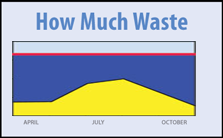Climate change in Edmonton: The promise of warmer weather but chilling effects
EDMONTON - The Edmonton area’s familiar landscape of aspen forest and grasslands will likely give way to Calgary’s treeless prairie over the next decades as summers become drier and temperatures rise, says a new report by the Alberta Biodiversity Monitoring Institute.

The province’s climate faces warming by at least two degrees caused by heat-trapping greenhouse gas emissions, says the report written by University of Alberta biologist Richard Schneider. Extreme weather events such as this year’s flooding in Calgary will be more likely.Photograph by: Lorraine Hjalte, Calgary Herald
The province’s climate faces warming by at least two degrees caused by heat-trapping greenhouse gas emissions, says the report written by University of Alberta biologist Richard Schneider.
“At two degrees, life would go on, Edmontonians would notice warmer winters, earlier spring, farmers could plant different crops, we could plant different species of trees, ” said Schneider, adding there will be “winners and losers” as the climate warms.
Extreme weather events such as this year’s flooding in Calgary will be more likely. “That is the kind of thing one would expect under future climate,” Schneider said Tuesday.
The change in the landscape won’t happen over night. The trees in the mixed parkland landscape — the transition between prairie and boreal forest — will live for years. But if they are wiped out by fire or bugs, they won’t grow back the same way, he says.
“It’s a wake up call, the Alberta we’ve grown up with will be different” though its unclear how fast that will happen, says Schneider.
The institution, set up in 2007, is an arm’s length research body funded by the U of A, the province and the Climate Change and Emissions Management Corporation.
If carbon emissions continue to rise, temperatures in Alberta could rise a whopping 6.5 C by the end of the century, Schneider said.
In that worst-case scenario, the result would eventually be the “near complete loss” of the boreal forest, the mix of spruce, pine and aspen that cover the northern half the province, up to Wood Buffalo National Park.
That’s unlikely, Schneider said, “but it all depends on what action people take.”
Greenhouse gas emissions are still rising in oilsands production.
The report said that the climate of southern Alberta is moving north while the south of the province could be become as dry as parts of Montana or Idaho.
“Under higher temperatures, the land is getting baked and that drives off the moisture,” Schneider said.
Also, although the growing season will be longer by 30 to 50 per cent as spring comes earlier but there will be less rainfall in the summer months when crops and vegetation need the moisture, the report said. Water levels in lakes will likely go down and wetlands will shrink.
Droughts are hard to predict but “the trend toward generally drier conditions across much of Alberta implies severe dry spells will become more frequent in the future and affect more of the province,” the report said.
Alberta Environment welcomed the report as a useful tool in figuring out strategies and for land-use planning, said Nikki Booth, issues manager.
The province wants to reduce greenhouse gases by 50 megatonnes a year by 2020. So far the province has reduced those emissions an average of five megatonnes a year and by 2020, the annual reduction will be 14 megatonnes.
Booth noted that the province has collected $398 million in levies from companies that have not met their carbon reduction targets. Alberta requires large emitters reduce emissions 12 per cent or pay a penalty of $15 a ton.
That levy is used to fund 53 clean-energy projects.
Eric Newell, who runs the emissions management corporation, said he’s pleased with the report. “Now we can start planning for (the impacts of climate change),” such as new forest management techniques.
Newell also said the oil industry knows it must aim for an “absolute reduction” carbon emissions, rather than just lowering the emissions per barrel. But the “transformative technology” will take years to develop, he added.
“With rising energy demand for energy, it’s quite a challenge,” said Newell, adding he expects oilsand production to increase to meet work demand.


